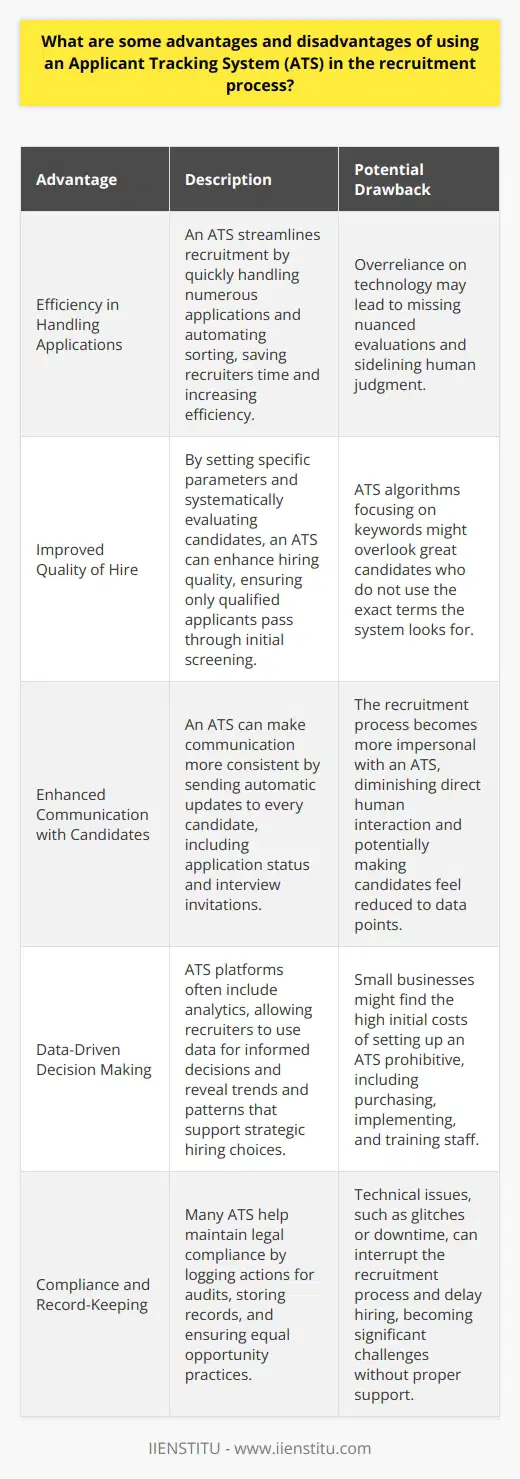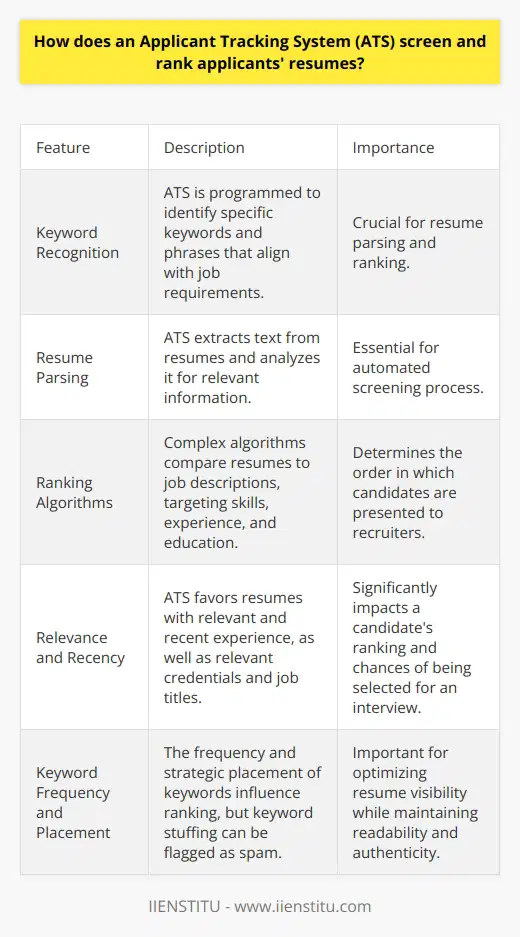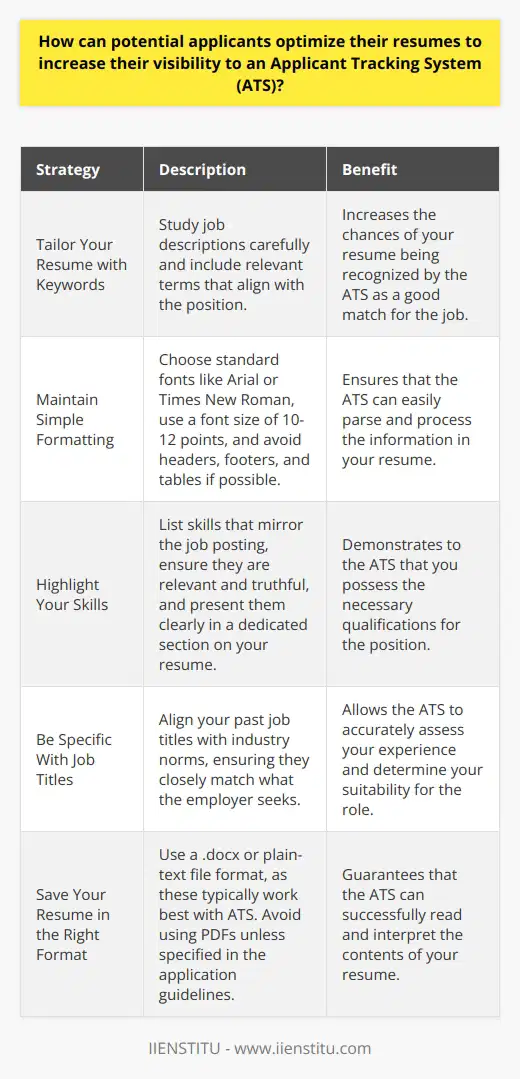In the intricate dance of modern recruitment, the Applicant Tracking System (ATS) has emerged as an indispensable partner, choreographing the steps between organizations and their prospective talents. This technological facilitator has become an essential part of human resource departments, vastly impacting the efficiency and effectiveness of the hiring process. In this article, we will conduct a comprehensive examination of ATS, dissect its functionalities, discuss its pivotal attributes, and navigate the influence it bears upon both employers and job seekers. To do this, we will draw upon the latest insights and best practices, aiming to serve as both a guide and a thought-provoking read for our audience.
Understanding the Working of an ATS
Explaining the Functionality of ATS
At the core of an ATS lies its ability to parse resumes, a complex endeavor that transforms unstructured data into a structured format. This enables the system to dissect and analyze the contents of a resume, screening for qualifications, experience, and other relevant criteria that meet a job's requirements. Moreover, the sorting and ranking of candidates streamline the selection process, effectively creating an ordered list of candidates based on the match between their profile and the job specifications. From this orderly cohort, ATS integrations further connect with other HR tools and databases, unifying the recruitment effort into a cohesive system.
The Role of ATS in Streamlining Recruitment
As the volume of applications surmounts, an ATS becomes the harbinger of relief for recruiters, automating repetitive tasks such as sending acknowledgments of received applications or scheduling interviews. The time saved directly translates into a more intense focus on engaging with potential hires, allowing for a deeper dive into the nuances of a candidate's profile. Additionally, enhancing recruitment efficiency not only accelerates the timeframe from posting a job to filling the position but also contributes to a better overall candidate experience.
Key Features to Look for in an ATS
User-Friendly Interface: A quintessential property of a high-caliber ATS is a user-friendly interface that simplifies adoption and minimizes the learning curve for new users. An intuitive dashboard, clear navigational cues, and seamless user flow ensure that recruiters can focus on their primary job—identifying and engaging with suitable candidates—without fretting over the complexities of software manipulation.
Streamlined Communication Channels: Efficient communication within the hiring team and with applicants is foundational to a successful recruitment process. An ATS that provides streamlined communication channels, facilitates easier collaboration among team members and maintains a line of communication with candidates. It ensures that the recruitment process is transparent, comprehensive, and conducive to a positive relationship with all stakeholders.
Robust Reporting and Analytics: In the realm of recruitment, decision-making is only as good as the data it's based on. An ATS with robust reporting and analytics capabilities enables human resource managers to track and measure the effectiveness of their recruitment strategies, and make informed adjustments as necessary. This data-centric approach underpins strategic planning and can lead to continuous improvement in talent acquisition.
The Impact of ATS on Job Seekers
The Importance of Keyword Optimization
For job seekers, understanding the ATS's functioning is crucial. Successful applicants recognize the importance of keyword optimization tailored to each job posting. They strategically sprinkle relevant terms throughout their resumes and cover letters, knowing full well that their documents' initial screening will likely be performed by an ATS.
Common Mistakes Job Seekers Make When Dealing with ATS
Long Tail Keyword For Human Capital Management İn Organizational Success
Most Searched Keyword: Hr Research For Organizational Success
Despite an abundance of advice available, many job seekers still fall prey to common mistakes that an ATS will swiftly penalize. Overly elaborate formats, graphics, and unconventional section headings can confuse resume-parsing algorithms, leading to the exclusion of potentially qualified candidates from the recruitment process.
Examples of ATS-Friendly Resumes
ATS-friendly resumes often adhere to simplicity in design, with clear headings, consistent formatting, and straightforward chronology of employment. Inclusion of specific and relevant job titles, as well as measurable achievements using industry-recognized metrics, further improves the likelihood of an ATS recognizing the candidate's suitability for a position.
Evaluating the Pros and Cons of Using ATS
Benefits of Using ATS
The deployment of an ATS can significantly refine the hiring process. Improvements such as enhanced collaboration among hiring team members foster a unified recruitment approach. An ATS's coherent and structured process can amplify the quality of hire by ensuring only the most fitting candidates advance. Additionally, the reduced time to hire is a testament to the streamlining capabilities of an ATS, crucial in sectors where filling vacancies promptly is paramount.
Potential Limitations of ATS
While ATS systems boast numerous advantages, they are not without their constraints. One significant limitation is the perennial risk of overlooking potentially suitable candidates, especially those who may not be adept at gaming ATS algorithms with keyword optimization. Moreover, there's an inherent depersonalization of the hiring process; the warm touch of human interaction can sometimes be lost amidst the automation and standardization that ATS provides.
Making the Most of ATS: Best Practices for Recruiters
Ensuring Correct Usage of Keywords in Job Postings: It is essential for recruiters to seed their job postings with the correct keywords relevant to the position. This standardizes job descriptions and criteria, allowing an ATS to more effectively match candidates with job postings, and vice versa.
Regular System Updates: Keeping an ATS updated is crucial to ensure it functions with optimal efficiency and incorporates the latest advancements in technology—an outdated system could potentially mismanage candidates or overlook key pieces of information.
Training for HR Staff in Using ATS Efficiently: An ATS is as effective as those who wield it. Therefore, providing adequate human resources certification course or other pertinent online courses to HR staff can empower them to leverage the ATS to its fullest potential, benefiting the entire recruitment process.
The Future of ATS: Emerging Trends and Predicted Enhancements
Integration of AI and Machine Learning: The future of ATS systems seems inextricably linked with the continued integration of AI and machine learning technologies. These advancements could revolutionize the way candidates' data is interpreted, allowing for more nuanced assessments that may transcend traditional keyword matching.
Predictive Analytics in ATS: Predictive analytics could enable recruiters to foresee trends and outcomes in the recruitment process, aiding in the strategic planning of workforce development and proactive talent acquisition.
Personalized Recruitment Experiences: As ATS systems evolve, they are predicted to offer more personalized experiences for candidates, mirroring the consumer experiences that individuals have grown accustomed to. This may include personalized job recommendations and engagement strategies that resonate on an individual level.
"In the realm of recruitment, decision-making is only as good as the data it's based on."
Conclusion
In summation, we have delved into the intricate workings of ATS and explored its manifold implications for both the world of recruitment and the journey of a job seeker. From the labyrinth of resume parsing to the heights of strategic analytics, ATS systems have shown their capacity to revolutionize hiring as we know it. As this field continues to evolve, it serves as a clarion call for businesses and individuals alike to remain abreast of these advancements and consider an ATS that aligns with their unique needs. ==Let us step forward in this digital age of recruitment with a refined understanding and appreciation for these remarkable tools.
Frequently Asked Questions
What are some advantages and disadvantages of using an Applicant Tracking System (ATS) in the recruitment process?
Advantages of Using an Applicant Tracking System
Efficiency in Handling Applications
An Applicant Tracking System, or ATS, streamlines recruitment. It handles numerous applications quickly. Recruiters save time with automated sorting. This swift processing aids in organization. Efficiency increases as manual tasks decrease.
Improved Quality of Hire
An ATS can enhance hiring quality. It does this through systematic candidate evaluation. Recruiters set specific parameters. Only qualified applicants pass through initial screening.
Enhanced Communication with Candidates
Communication can become more consistent with an ATS. Every candidate receives automatic updates. These updates can include application status or interview invitations.
Data-Driven Decision Making
ATS platforms often include analytics. Recruiters can use data for informed decisions. The data may reveal trends and patterns. These insights support strategic choices in hiring.
Compliance and Record-Keeping
Many systems help maintain legal compliance. An ATS can log actions for audits. It stores records and ensures equal opportunity practices.
Disadvantages of Using an Applicant Tracking System
High Initial Costs
Setting up an ATS requires investment. Small businesses might find costs prohibitive. The cost includes purchasing, implementing, and training staff.
Risk of Filtering Out Good Candidates
ATS algorithms focus on keywords. They might overlook great candidates. These potential hires might not use the exact terms the system looks for.
Lack of Personal Touch
Recruitment becomes more impersonal with an ATS. Direct human interaction diminishes. Candidates might feel reduced to a set of data points.
Overreliance on Technology
Recruiters may become too dependent on an ATS. They risk missing nuanced evaluations. Human judgment gets sidelined by automation preferences.
Potential Technical Issues
Technical issues can interrupt the recruitment process. Glitches or downtime can delay hiring. Without proper support, these challenges can become significant.
By summarizing these points, we recognize an ATS bears both promise and pitfalls. Organizations must weigh the potential for streamlined efficiency against the risk of depersonalizing and narrowing their search for talent. Careful implementation and a balanced approach to technology can help harness the benefits while mitigating the risks.

How does an Applicant Tracking System (ATS) screen and rank applicants' resumes?
Understanding Applicant Tracking Systems (ATS)
ATS Mechanisms Explained
An Applicant Tracking System simplifies hiring. It automates resume screening. First, it parses resumes. This involves extracting text. Then it analyzes this text. Keywords and phrases are crucial. The ATS is programmed to recognize them. These often align with job requirements.
How ATS Ranks Candidates
Ranking involves comparison. Resumes are compared to job descriptions. Each resume gets a score. Higher scores mean stronger matches. The system uses complex algorithms. These algorithms target specific criteria. They look for skills, experience, and education.
Importance of Resume Optimization
Applicants should optimize resumes for ATS. This means using relevant keywords. It also requires clear formatting. Standard headings are important. They guide the ATS effectively. Complex layouts can confuse the system.
The Role of Relevance
Relevance cannot be overstressed. The ATS favors recent and relevant experience. It screens for credentials. Degrees and certifications matter. It evaluates job titles as well. Past roles add context.
The Impact of Frequency and Placement
Keyword frequency influences ranking. However, keyword stuffing does not work. The ATS can flag it as spam. The placement of keywords matters too. Strategic placement is key. Important qualifications should stand out.
Additional Considerations
Many ATS systems analyze work history. Gaps in employment can affect scores. Consistent career progression is positive. Volunteering and internships can be beneficial. So can special projects and achievements.
What Applicants Need to Know
- Use simple, clear language.
- Mirror language from the job description.
- Prioritize readability and relevance.
- Avoid tables, charts, and images.
- Provide context for each role.
- Highlight transferable skills.
- Dynamic work histories score well.
- Proofreading is essential.
- Online tools can pre-evaluate resumes.
Conclusion
Applicant Tracking Systems simplify recruiting. They do so by objectively evaluating resumes. Understand their functioning. Optimize your resume accordingly. This can vastly improve your chances. Remember, an ATS-friendly resume is critical. It makes the difference in today's job market.

How can potential applicants optimize their resumes to increase their visibility to an Applicant Tracking System (ATS)?
Applicant Tracking Systems (ATS) have transformed the hiring landscape. They allow employers to manage high volumes of applications efficiently. As an applicant, understanding how these systems work can increase the odds of your resume passing through successfully.
ATS Optimization Strategies
Tailor Your Resume with Keywords
The heart of ATS optimization is using the right keywords. Study job descriptions carefully. Include relevant terms that align with the position.
Maintain Simple Formatting
ATS can struggle with complex layouts. Choose simplicity. Opt for standard fonts like Arial or Times New Roman. Use a font size of 10-12 points. Avoid headers, footers, and tables if possible.
Use Standard Resume Sections
Stick to conventional headings. Examples are "Work Experience," "Education," and "Skills." This approach helps ATS software locate and process your information more accurately.
Highlight Your Skills
List skills that mirror the job posting. Ensure they are relevant and truthful. Present them clearly in a dedicated section on your resume.
Avoid Images and Graphics
Many ATS cannot read images or graphs. Incorporate only text in your resume. This makes all your information accessible to the software.
Be Specific With Job Titles
Align your past job titles with industry norms. The closer your titles match what the employer seeks, the better the ATS can assess your experience.
Provide Context for Abbreviations
Incorporate both the acronym and its spelled-out form. This ensures ATS recognition regardless of the search term used.
Focus On Content Over Style
Your resume's content weighs more heavily than its design. Ensure you present a solid work history and skills over creative layouts.
Use a Chronological or Hybrid Resume Format
Opt for a reverse-chronological or hybrid format. These are more ATS-friendly. Functional resumes may confuse the system.
Include a Summary Section
Craft a resume summary that encapsulates your qualifications. Gear it towards the position at hand. This offers an ATS an overview of your fit for the role.
Save Your Resume in the Right Format
A .docx or a plain-text file typically works best with ATS. Some systems struggle with PDFs. Read the application guidelines to choose the right format.
Proofread Meticulously
Errors can derail an ATS's interpretation of your resume. Review your document carefully. Check for spelling and grammatical errors that could confuse the software.
Use Social Media to Your Advantage
Link to your professional online profiles like LinkedIn. Ensure your profile matches your resume. Some ATS integrate social media to form a more complete picture of applicants.
Keep Up with ATS Trends
Stay informed about new developments in ATS technology. Tips that work today may not apply tomorrow. Always look for updated advice.
In a competitive job market, differentiate your resume with ATS optimization. It may be that crucial step in landing your next interview.



